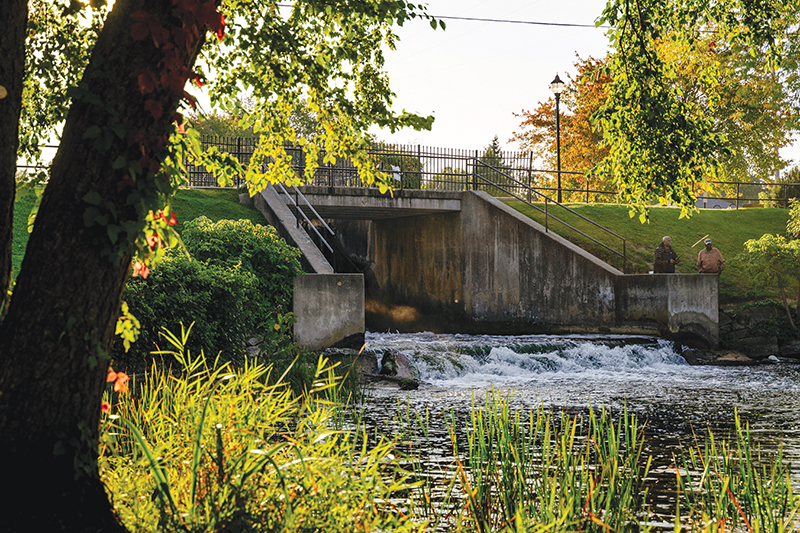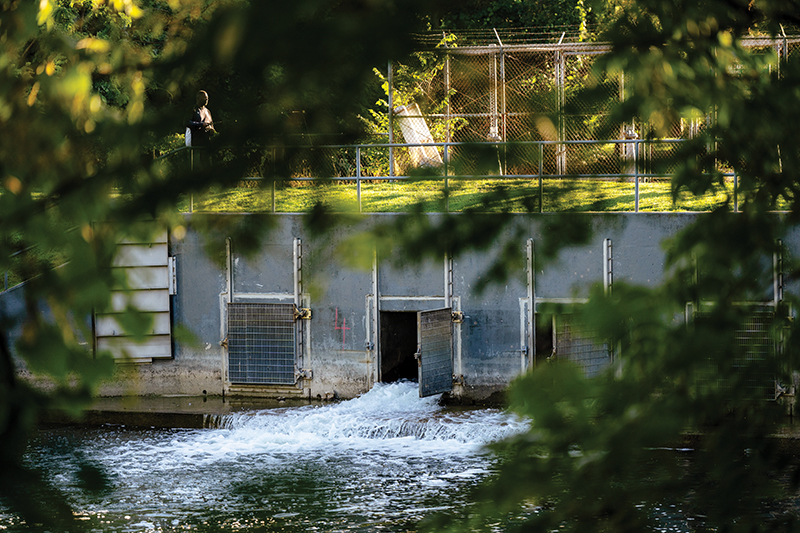
It was a story horrific enough to briefly displace COVID-19 at the top of the news in the teeth of the pandemic — a pair of dam collapses along the Tittabawassee River in central Michigan that emptied Wixom Lake and plunged parts of Midland, population 40,000, under 9 feet of water. Remarkably, nobody died, but the nine-figure cost has yet to be fully tallied.
To metro Detroiters, it seemed like a traumatic but remote matter, a type of calamity associated in our state with the rural and small towns due north. But what if it’s a harbinger of threats to come? The American Society of Civil Engineers (ASCE) says four of every five dams in Michigan — there are more than 2,000 — will exceed the typical 50-year design life of such structures by 2023, and dozens of them manage water flows in and around our urban and suburban landscapes.
And here’s a more chilling statistic: There are 32 dams in the region that are categorized as “high hazard,” according to a U.S. Army Corps of Engineers database. That means if they broke loose, they would cause significant destruction. And while state and federal inspectors insist they are perfectly sound, the average age of those 32 dams, which may be all that stands in the way of you needing a rowboat to cross your living room, is 92.5 years.
The state seems OK with this level of risk. “It’s relatively flat down there, so the dams aren’t typically that big,” state dam inspector Luke Trumble says. “There’s not a whole lot of dams in southeast Michigan that pose the kind of threat that dams in Midland or some of the other areas of Michigan do, or did.” Still, a collapse doesn’t have to drown an entire city to be horrific for a specific neighborhood.

While the dams of southeast Michigan are officially OK right now, the forces of erosion that have always been at work have been joined by climate change, stressing dams more than ever. “Not only are they aging, but with climate change we are getting more punctuated flash floods and heavy rains,” says John Waldman, a biology professor at Queens College in New York. “The harder the precipitation, the more a dam is tested, and you saw that with the dams in Michigan.”
One solution: Remove the dams and restore the natural flow of the river. Most of these dams are due for expensive face-lifts because of their ages anyway, and those originally built to produce electricity are no longer, in the age of nuclear, solar, and fossil-fuel power, a vital regional energy source.
“This is the issue right now,” says George Jackman, habitat restoration manager for Riverkeeper, a clean water advocacy group based in New York. “Society is facing a monumental task in what to do with these dams. To do nothing is the biggest problem. You either have to repair them or remove them. That’s the choice. Nothing else.”
Eventually, fixes or removals will be needed if communities are to stay safe and dry. Replacing or removing a dam can cost tens of millions of dollars, although removal is usually cheaper. But cash is lacking for any option, especially repair.

“Here’s the deal: There’s very little public money available to maintain, repair, or build dams,” says Jim Hegarty, the former Michigan section president of ASCE, which co-authored the 2018 infrastructure report card. “The only money that’s available is to take dams out, and it’s not going to dam safety concern. It’s going through environmental concerns, because that’s where the money is. [Environmental groups are] able to say, ‘We’re going to do it for habitat reconnection. We’re going to do it for water quality.’”
That’s certainly true in Michigan, which allows dedicated state habitat restoration funds to be used for dam removal and is more flexible in enabling removals than some other states. In the past decade, dams have been removed along the Boardman, Grand, Black, and Pigeon rivers. Last year alone, five small dams were demolished, including the 176-year-old Corunna Dam on the Shiawassee River near Owosso.
“It’s actually not that difficult in Michigan,” says Lisa Hollingsworth-Segedy, director of river restorations for the nonprofit group American Rivers. “Michigan is among a number of states that allow dam removal for ecological reasons, and Michigan has been a leader in dam removal, especially in the Midwest.”
Yet one powerful interest often stands in the way of dam removals: homeowners. In fact, the state’s recommendation after the Midland disaster is to remove the dams, an idea that is anathema to residents accustomed to enjoying boating from their backyards and to the spectacular scenery that comes with living on waterfront property. Many lakeside residents are eager to see the failed dams repaired — possibly at a cost of nearly $100,000 a homeowner — and the lake restored.
If the state or federal government tried to permanently undam the Tittabawassee River, Wixom Lake homeowner Robert Beltz told Michigan Radio in June, “you’d see 10,000 people around this lake. They’d all be out with pitchforks and torches. None of them want to see the lake disappear, and I do not see that as an option.”

To activists like Jackman, it’s a matter of environmental justice, a sense that those protecting dams are doing the bidding of the wealthy at the expense of both the less affluent and of the river and its wildlife. But Hollingsworth-Segedy is more empathetic to the objections to altering artificial reservoirs that people for generations have viewed as “natural” fixtures that would always exist.
“This is a hard issue for a lot of people to wrap their heads around,” she says. “In a lot of cases, the lakes that we’ve enjoyed because of the dams being in place have become part of our heritage, part of our culture, part of our everyday lives. We go out to the lake to recreate. It’s where we learn to swim. It’s where Grandpa took us fishing. The dams, in many cases, have been on the landscape for so long that no one alive can remember the river without the dam being there.”
Yet removal proponents insist the loss of a dam doesn’t necessarily mean an end to backyard beauty. Over time, sediment-rich dry lake beds revert into lush river valleys. “If you remove a reservoir, you still have a river to play in,” says Waldman, the Queens College biologist. “You can’t water ski, but you can kayak and canoe and fish and have a really healthy system that is both beautiful and has recreational use.”
And Jackman says the choice confronting the folks of Wixom Lake will sooner or later be faced across the state as so much of this infrastructure continues to age and crumble. “We’re going to have to make some hard decisions about these dams,” he says. “And some people are going to be unhappy.”

There are 32 dams in Oakland, Wayne, Macomb, Genesee, Washtenaw, and Livingston counties rated as “high hazard,” meaning a collapse would cause significant downstream destruction.
Twenty-three of them are more than 80 years old — one, the Nichwagh Lake Dam in Livingston County, is 190 years old — but state officials say routine inspections have found them in decent shape. Here is a list of those dams (approximate ages in parentheses):
Oakland County
Average age: 81.4 years
Clarkston Dam (120), Dawson Millpond Dam (105), Heron Dam (51), Lake Louise Dam (95), Lake Neva Dam (65), Oxbow Lake Dam (56), Pontiac Lake Dam (100), Wildwood Lake Dam (59).
Macomb County
Average age: 59 years
Lower Stony Lake Dam (59), Upper Stony Lake Dam (59).
Livingston County
Average age: 140 years
Hiland Lake Dam (138), Nichwagh Lake Dam (190), Woodland Lake Dam (92).
Wayne County
Average age: 88.8 years
Detroit Metro Airport Stormwater Pond 6 Dam (50), Flat Rock Dam (96), French Landing Dam (96), Nankin Mill Dam (99), Newburgh Dam (87), Waterford Dam (95), Wilcox Dam (87), Phoenix Dam (100).
Genesee County
Average age: 73 years
Hamilton Dam (100), Holloway Dam (66), Linden Mill Dam (53).
Washtenaw County
Average age: 105.1 years
Ford Lake Dam (88), Ford Manchester Dam (80), Peninsular Paper Dam (153), Superior Dam (101), Argo Dam (100), Barton Dam (107), Geddes Dam (100), Manchester Mill Dam (112).
(Source: National Inventory of Dams Database)
|
|
|









